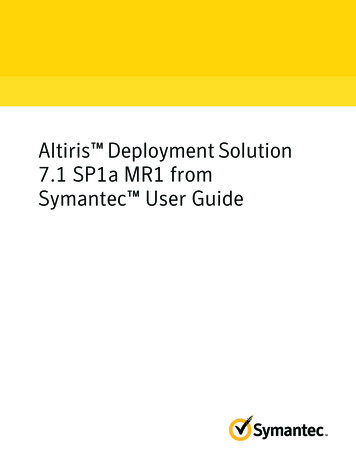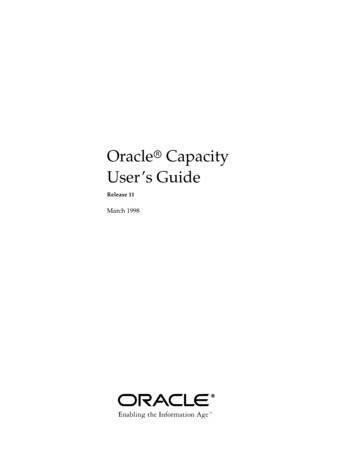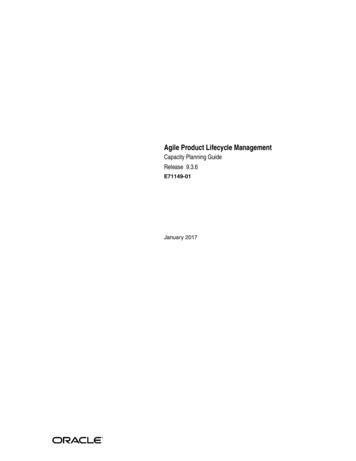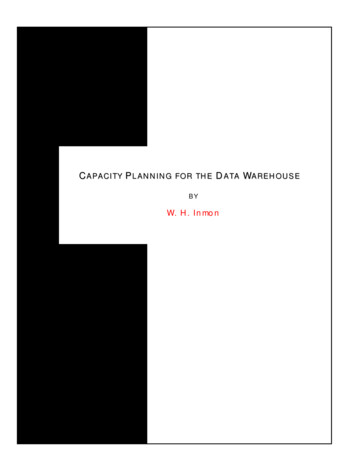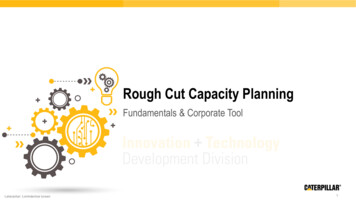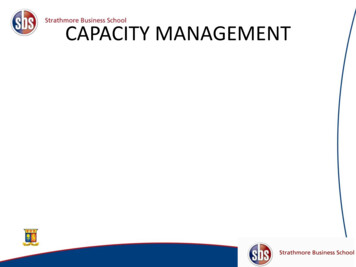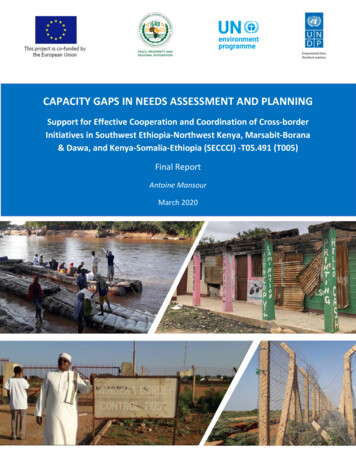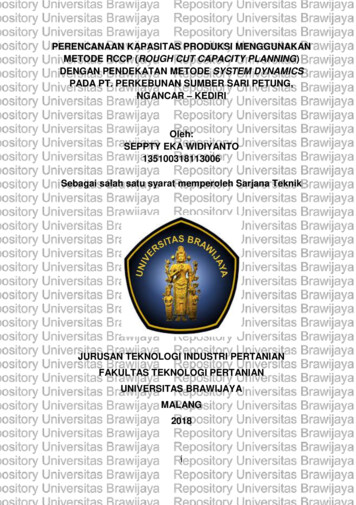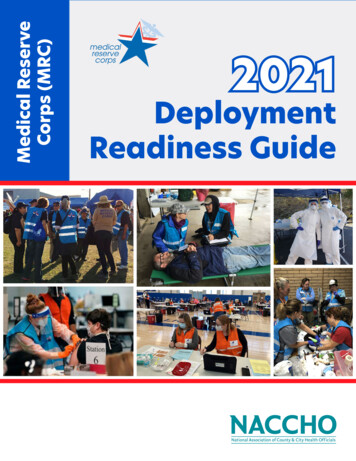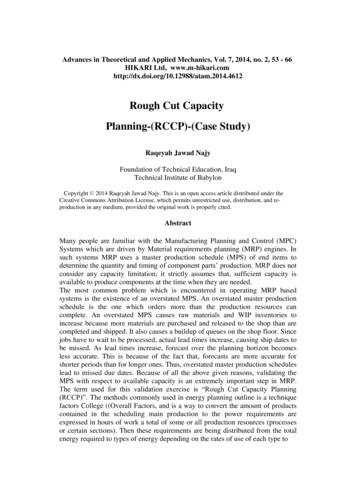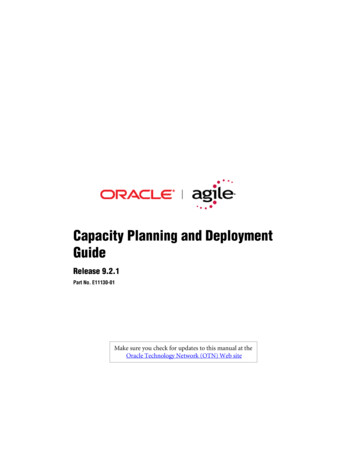
Transcription
Capacity Planning and DeploymentGuideRelease 9.2.1Part No. E11130-01Make sure you check for updates to this manual at theOracle Technology Network (OTN) Web site
Agile PLM 9.2.1Copyrights and TrademarksCopyright 1995, 2007, Oracle. All rights reserved.The Programs (which include both the software and documentation) contain proprietary information; they areprovided under a license agreement containing restrictions on use and disclosure and are also protected bycopyright, patent, and other intellectual and industrial property laws. Reverse engineering, disassembly, ordecompilation of the Programs, except to the extent required to obtain interoperability with other independentlycreated software or as specified by law, is prohibited.The information contained in this document is subject to change without notice. If you find any problems in thedocumentation, please report them to us in writing. This document is not warranted to be error-free. Except as maybe expressly permitted in your license agreement for these Programs, no part of these Programs may be reproducedor transmitted in any form or by any means, electronic or mechanical, for any purpose.If the Programs are delivered to the United States Government or anyone licensing or using the Programs on behalfof the United States Government, the following notice is applicable:U.S. GOVERNMENT RIGHTS Programs, software, databases, and related documentation and technical datadelivered to U.S. Government customers are "commercial computer software" or "commercial technical data"pursuant to the applicable Federal Acquisition Regulation and agency-specific supplemental regulations. As such,use, duplication, disclosure, modification, and adaptation of the Programs, including documentation and technicaldata, shall be subject to the licensing restrictions set forth in the applicable Oracle license agreement, and, to theextent applicable, the additional rights set forth in FAR 52.227-19, Commercial Computer Software--RestrictedRights (June 1987). Oracle USA, Inc., 500 Oracle Parkway, Redwood City, CA 94065.The Programs are not intended for use in any nuclear, aviation, mass transit, medical, or other inherently dangerousapplications. It shall be the licensee's responsibility to take all appropriate fail-safe, backup, redundancy and othermeasures to ensure the safe use of such applications if the Programs are used for such purposes, and we disclaimliability for any damages caused by such use of the Programs.Oracle and Agile are registered trademarks of Oracle Corporation and/or its affiliates. Other names may betrademarks of their respective owners.The Programs may provide links to Web sites and access to content, products, and services from third parties. Oracleis not responsible for the availability of, or any content provided on, third-party Web sites. You bear all risksassociated with the use of such content. If you choose to purchase any products or services from a third party, therelationship is directly between you and the third party. Oracle is not responsible for: (a) the quality of third-partyproducts or services; or (b) fulfilling any of the terms of the agreement with the third party, including delivery ofproducts or services and warranty obligations related to purchased products or services. Oracle is not responsible forany loss or damage of any sort that you may incur from dealing with any third party.September 13, 2007iiCapacity Planning and Deployment
R EVISIONSRevisionDatePages AffectedDescriptionA06/23/06AllInitial release of manual.B07/10/069-1Added JVM parameters for Solaris.C07/17/066-4Changed caching view server description.D07/19/063-2Changed the name of Table 3-3. Added Table 3-5, Change Status to Released(Each Item has at least 3 Pending Changes.9-1Removed “Using Compression Filters.”E07/24/06PrefaceCorrected Training Website URL.F07/26/061-4Added Linux as a supported platform for Apache 2.0.55.G08/09/061-4Corrected Windows 2003 version number.iii
Agile PLM 9.2.1ivCapacity Planning and Deployment
C ONTENTSChapter 1OverviewOverview . . . . . . . . . . . . . . . . . . . . . . . . . . . . . . . . . . . . . . . . . . . . . . . . . . . . . . . . . . . . . . . . . . . . . . . . . . . . . . . . . . . . . . . . . .Application Server . . . . . . . . . . . . . . . . . . . . . . . . . . . . . . . . . . . . . . . . . . . . . . . . . . . . . . . . . . . . . . . . . . . . . . . . . . . . . .Load Balancer . . . . . . . . . . . . . . . . . . . . . . . . . . . . . . . . . . . . . . . . . . . . . . . . . . . . . . . . . . . . . . . . . . . . . . . . . . . . . . . . . .Clients . . . . . . . . . . . . . . . . . . . . . . . . . . . . . . . . . . . . . . . . . . . . . . . . . . . . . . . . . . . . . . . . . . . . . . . . . . . . . . . . . . . . . . . .Database Server. . . . . . . . . . . . . . . . . . . . . . . . . . . . . . . . . . . . . . . . . . . . . . . . . . . . . . . . . . . . . . . . . . . . . . . . . . . . . . . . .Agile File Manager . . . . . . . . . . . . . . . . . . . . . . . . . . . . . . . . . . . . . . . . . . . . . . . . . . . . . . . . . . . . . . . . . . . . . . . . . . . . . .LDAP Directory Server . . . . . . . . . . . . . . . . . . . . . . . . . . . . . . . . . . . . . . . . . . . . . . . . . . . . . . . . . . . . . . . . . . . . . . . . . .View Server . . . . . . . . . . . . . . . . . . . . . . . . . . . . . . . . . . . . . . . . . . . . . . . . . . . . . . . . . . . . . . . . . . . . . . . . . . . . . . . . . . . .Software Requirements . . . . . . . . . . . . . . . . . . . . . . . . . . . . . . . . . . . . . . . . . . . . . . . . . . . . . . . . . . . . . . . . . . . . . . . . . . . . . .Hardware Requirements . . . . . . . . . . . . . . . . . . . . . . . . . . . . . . . . . . . . . . . . . . . . . . . . . . . . . . . . . . . . . . . . . . . . . . . . . . . . .Chapter 21-11-11-11-11-11-21-21-21-41-5Capacity PlanningHardware Sizing . . . . . . . . . . . . . . . . . . . . . . . . . . . . . . . . . . . . . . . . . . . . . . . . . . . . . . . . . . . . . . . . . . . . . . . . . . . . . . . . . . . . 2-1Agile Application Server . . . . . . . . . . . . . . . . . . . . . . . . . . . . . . . . . . . . . . . . . . . . . . . . . . . . . . . . . . . . . . . . . . . . . . . . . . . . . 2-2Hardware Sizing for Windows and Linux . . . . . . . . . . . . . . . . . . . . . . . . . . . . . . . . . . . . . . . . . . . . . . . . . . . . . . . . . . . . . . . 2-3Hardware Sizing for Solaris. . . . . . . . . . . . . . . . . . . . . . . . . . . . . . . . . . . . . . . . . . . . . . . . . . . . . . . . . . . . . . . . . . . . . . . . . . . 2-4Database Server Sizing . . . . . . . . . . . . . . . . . . . . . . . . . . . . . . . . . . . . . . . . . . . . . . . . . . . . . . . . . . . . . . . . . . . . . . . . . . . . . . . 2-5Oracle Database Sizing. . . . . . . . . . . . . . . . . . . . . . . . . . . . . . . . . . . . . . . . . . . . . . . . . . . . . . . . . . . . . . . . . . . . . . . . . . . 2-5Hardware Resource Plan for Database Models . . . . . . . . . . . . . . . . . . . . . . . . . . . . . . . . . . . . . . . . . . . . . . . . . . . . . . . 2-7Disk Space and Tablespace Configurations . . . . . . . . . . . . . . . . . . . . . . . . . . . . . . . . . . . . . . . . . . . . . . . . . . . . . . . . . . 2-7Hardware Load Balancer and Proxy Web Server . . . . . . . . . . . . . . . . . . . . . . . . . . . . . . . . . . . . . . . . . . . . . . . . . . . . . . . . . 2-10CPU . . . . . . . . . . . . . . . . . . . . . . . . . . . . . . . . . . . . . . . . . . . . . . . . . . . . . . . . . . . . . . . . . . . . . . . . . . . . . . . . . . . . . . . . . 2-10Network Card . . . . . . . . . . . . . . . . . . . . . . . . . . . . . . . . . . . . . . . . . . . . . . . . . . . . . . . . . . . . . . . . . . . . . . . . . . . . . . . . . 2-10Distributed File Management . . . . . . . . . . . . . . . . . . . . . . . . . . . . . . . . . . . . . . . . . . . . . . . . . . . . . . . . . . . . . . . . . . . . . . . . 2-10View Server . . . . . . . . . . . . . . . . . . . . . . . . . . . . . . . . . . . . . . . . . . . . . . . . . . . . . . . . . . . . . . . . . . . . . . . . . . . . . . . . . . . . . . . 2-10Chapter 3Breakpoint Testing ResultsSolution Results on Windows and Linux. . . . . . . . . . . . . . . . . . . . . . . . . . . . . . . . . . . . . . . . . . . . . . . . . . . . . . . . . . . . . . . . 3-1Product Collaboration . . . . . . . . . . . . . . . . . . . . . . . . . . . . . . . . . . . . . . . . . . . . . . . . . . . . . . . . . . . . . . . . . . . . . . . . . . . 3-2Product Quality Management . . . . . . . . . . . . . . . . . . . . . . . . . . . . . . . . . . . . . . . . . . . . . . . . . . . . . . . . . . . . . . . . . . . . . 3-3Distributed File Manager . . . . . . . . . . . . . . . . . . . . . . . . . . . . . . . . . . . . . . . . . . . . . . . . . . . . . . . . . . . . . . . . . . . . . . . . . 3-5Export . . . . . . . . . . . . . . . . . . . . . . . . . . . . . . . . . . . . . . . . . . . . . . . . . . . . . . . . . . . . . . . . . . . . . . . . . . . . . . . . . . . . . . . . 3-5Product Cost Management . . . . . . . . . . . . . . . . . . . . . . . . . . . . . . . . . . . . . . . . . . . . . . . . . . . . . . . . . . . . . . . . . . . . . . . 3-6Solution Results on Solaris . . . . . . . . . . . . . . . . . . . . . . . . . . . . . . . . . . . . . . . . . . . . . . . . . . . . . . . . . . . . . . . . . . . . . . . . . . . 3-7Product Collaboration . . . . . . . . . . . . . . . . . . . . . . . . . . . . . . . . . . . . . . . . . . . . . . . . . . . . . . . . . . . . . . . . . . . . . . . . . . . 3-8Product Quality Management . . . . . . . . . . . . . . . . . . . . . . . . . . . . . . . . . . . . . . . . . . . . . . . . . . . . . . . . . . . . . . . . . . . . . 3-8Distributed File Manager . . . . . . . . . . . . . . . . . . . . . . . . . . . . . . . . . . . . . . . . . . . . . . . . . . . . . . . . . . . . . . . . . . . . . . . . . 3-9Product Cost Management . . . . . . . . . . . . . . . . . . . . . . . . . . . . . . . . . . . . . . . . . . . . . . . . . . . . . . . . . . . . . . . . . . . . . . 3-11Portlets Performance . . . . . . . . . . . . . . . . . . . . . . . . . . . . . . . . . . . . . . . . . . . . . . . . . . . . . . . . . . . . . . . . . . . . . . . . . . . . . . . 3-12Chapter 4Client RequirementsClient Requirements . . . . . . . . . . . . . . . . . . . . . . . . . . . . . . . . . . . . . . . . . . . . . . . . . . . . . . . . . . . . . . . . . . . . . . . . . . . . . . . . 4-1v
Agile PLM 9.2.1Chapter 5Directory ServerOverview . . . . . . . . . . . . . . . . . . . . . . . . . . . . . . . . . . . . . . . . . . . . . . . . . . . . . . . . . . . . . . . . . . . . . . . . . . . . . . . . . . . . . . . . . .System Architecture . . . . . . . . . . . . . . . . . . . . . . . . . . . . . . . . . . . . . . . . . . . . . . . . . . . . . . . . . . . . . . . . . . . . . . . . . . . . . . . . .Implementation Details . . . . . . . . . . . . . . . . . . . . . . . . . . . . . . . . . . . . . . . . . . . . . . . . . . . . . . . . . . . . . . . . . . . . . . . . . .Configuration . . . . . . . . . . . . . . . . . . . . . . . . . . . . . . . . . . . . . . . . . . . . . . . . . . . . . . . . . . . . . . . . . . . . . . . . . . . . . . . . . .Utilities . . . . . . . . . . . . . . . . . . . . . . . . . . . . . . . . . . . . . . . . . . . . . . . . . . . . . . . . . . . . . . . . . . . . . . . . . . . . . . . . . . . . . . . . . . .Frequently Asked Questions (FAQ) . . . . . . . . . . . . . . . . . . . . . . . . . . . . . . . . . . . . . . . . . . . . . . . . . . . . . . . . . . . . . . . . . . . .Chapter 6File Management Server and View ServerAgile File Management Server . . . . . . . . . . . . . . . . . . . . . . . . . . . . . . . . . . . . . . . . . . . . . . . . . . . . . . . . . . . . . . . . . . . . . . . .File Vaults . . . . . . . . . . . . . . . . . . . . . . . . . . . . . . . . . . . . . . . . . . . . . . . . . . . . . . . . . . . . . . . . . . . . . . . . . . . . . . . . . . . . .Distributed File Manager . . . . . . . . . . . . . . . . . . . . . . . . . . . . . . . . . . . . . . . . . . . . . . . . . . . . . . . . . . . . . . . . . . . . . . . . .How Distributed File Manager Works . . . . . . . . . . . . . . . . . . . . . . . . . . . . . . . . . . . . . . . . . . . . . . . . . . . . . . . . . . . . . .File Management Security . . . . . . . . . . . . . . . . . . . . . . . . . . . . . . . . . . . . . . . . . . . . . . . . . . . . . . . . . . . . . . . . . . . . . . . .View Server . . . . . . . . . . . . . . . . . . . . . . . . . . . . . . . . . . . . . . . . . . . . . . . . . . . . . . . . . . . . . . . . . . . . . . . . . . . . . . . . . . . . . . . .View Server Security. . . . . . . . . . . . . . . . . . . . . . . . . . . . . . . . . . . . . . . . . . . . . . . . . . . . . . . . . . . . . . . . . . . . . . . . . . . . .Chapter 76-16-16-26-26-46-46-5Communication and Data FlowCommunication and Data Flow . . . . . . . . . . . . . . . . . . . . . . . . . . . . . . . . . . . . . . . . . . . . . . . . . . . . . . . . . . . . . . . . . . . . . . .Client Communication . . . . . . . . . . . . . . . . . . . . . . . . . . . . . . . . . . . . . . . . . . . . . . . . . . . . . . . . . . . . . . . . . . . . . . . . . .Proxy Web Server . . . . . . . . . . . . . . . . . . . . . . . . . . . . . . . . . . . . . . . . . . . . . . . . . . . . . . . . . . . . . . . . . . . . . . . . . . . . . . .Typical Network Configurations. . . . . . . . . . . . . . . . . . . . . . . . . . . . . . . . . . . . . . . . . . . . . . . . . . . . . . . . . . . . . . . . . . .Application Server . . . . . . . . . . . . . . . . . . . . . . . . . . . . . . . . . . . . . . . . . . . . . . . . . . . . . . . . . . . . . . . . . . . . . . . . . . . . . .Directory Server . . . . . . . . . . . . . . . . . . . . . . . . . . . . . . . . . . . . . . . . . . . . . . . . . . . . . . . . . . . . . . . . . . . . . . . . . . . . . . . .Distributed File Management . . . . . . . . . . . . . . . . . . . . . . . . . . . . . . . . . . . . . . . . . . . . . . . . . . . . . . . . . . . . . . . . . . . . .View Server . . . . . . . . . . . . . . . . . . . . . . . . . . . . . . . . . . . . . . . . . . . . . . . . . . . . . . . . . . . . . . . . . . . . . . . . . . . . . . . . . . . .Network Bandwidth Requirements . . . . . . . . . . . . . . . . . . . . . . . . . . . . . . . . . . . . . . . . . . . . . . . . . . . . . . . . . . . . . . . . . . . .Chapter uct InterchangeAbout Product Interchange. . . . . . . . . . . . . . . . . . . . . . . . . . . . . . . . . . . . . . . . . . . . . . . . . . . . . . . . . . . . . . . . . . . . . . . . . . . 8-1Product Interchange Requirements . . . . . . . . . . . . . . . . . . . . . . . . . . . . . . . . . . . . . . . . . . . . . . . . . . . . . . . . . . . . . . . . . . . . 8-1Chapter 9Performance TipsTuning Memory for Java Applets . . . . . . . . . . . . . . . . . . . . . . . . . . . . . . . . . . . . . . . . . . . . . . . . . . . . . . . . . . . . . . . . . . . . . . 9-1Optimum JVM Parameters on Solaris . . . . . . . . . . . . . . . . . . . . . . . . . . . . . . . . . . . . . . . . . . . . . . . . . . . . . . . . . . . . . . . . . . 9-1Appendix ASystem Configuration ExamplesSmall System Configuration . . . . . . . . . . . . . . . . . . . . . . . . . . . . . . . . . . . . . . . . . . . . . . . . . . . . . . . . . . . . . . . . . . . . . . . . . . A-1Medium System Configuration . . . . . . . . . . . . . . . . . . . . . . . . . . . . . . . . . . . . . . . . . . . . . . . . . . . . . . . . . . . . . . . . . . . . . . . A-2Large System Configuration . . . . . . . . . . . . . . . . . . . . . . . . . . . . . . . . . . . . . . . . . . . . . . . . . . . . . . . . . . . . . . . . . . . . . . . . . . A-2Extra Large System Configuration . . . . . . . . . . . . . . . . . . . . . . . . . . . . . . . . . . . . . . . . . . . . . . . . . . . . . . . . . . . . . . . . . . . . . A-3viCapacity Planning and Deployment
P REFACEThe Agile documentation set includes Adobe Acrobat PDF files. The Oracle Technology Network (OTN) Website contains the latest versions of the Oracle Agile PLM PDF files. You can view or download these manuals fromthe Web site, or you can ask your Agile administrator if there is an Oracle Agile Documentation folder available onyour network from which you can access the Oracle Agile documentation (PDF) files.To read the PDF files, you must use the free Adobe Acrobat Reader version 7.0 or later. This program can bedownloaded from the www.adobe.com.The Oracle Technology Network (OTN) Web site can be accessed through Help Manuals in both the Agile WebClient and the Agile Java Client. If applicable, earlier versions of Oracle Agile PLM documentation can be found onthe www.agile.com/support.If you need additional assistance or information, please contact support@agile.com or phone (408) 284-3900 forassistance.Before calling Agile Support about a problem with an Oracle Agile PLM manual, please have ready the full partnumber, which is located on the title page.ReadmeAny last-minute information about Oracle Agile PLM can be found in the Readme file on the Oracle TechnologyNetwork (OTN) Web site.Agile Training AidsGo to the Agile Training Web page for more information on Agile Training offerings.vii
Agile PLM 9.2.1viiiCapacity Planning and Deployment
C HAPTER 1OverviewOverviewThe Agile Solution has an N-tier, J2EE architecture. These tiers are typically deployed across several servers in aproduction environment: Application Server, File Manager, Web Server, Database Server, and View Server.Application ServerThe Agile Application Server is the center of the Agile system, the base for the PLM platform, where all commonservices and business logic reside for the entire solution. The Agile Application Server runs on industry-leading J2EEapplication servers. See Table 1-1 for the list of supported application servers. As Figure 1-1 illustrates, all clientservers and users connect to the Application Server either directly or indirectly. The application server connects tothe components in a persistence layer where product content is stored, the database server, the file manager, and theLDAP server.Load BalancerThe hardware load balancer brokers client communications without compromising the security of your internalnetwork. Clients communicate through the load balancer with the application server. There are no Agile Softwarecomponents running on the hardware load balancer. They are usually deployed in the Demilitarized Zone (DMZ)where it proxies requests from outside the corporate firewall to the application server in the Safe Zone. A loadbalancer is necessary if you are installing Oracle Application Servers in a cluster.ClientsAgile PLM 9.2.1 includes two clients, a Web client and a Java client. The Web client is a thin HTML client that usesfirewall-friendly protocols (HTTP/S). The Java client is a Java-based client that can use application server-specificprotocols, such as ORMI for Oracle Application Server and T3 for BEA WebLogic, to connect to the server. Eachclient has its own strengths and weaknesses from a functional, architectural, and performance standpoint. Thisdocument compares the clients from an architectural and performance standpoint.Database ServerThe Agile Database Server persists or stores all product content and system settings. Agile’s database server runs onOracle 9i or 10g.1-1
Agile PLM 9.2.1Agile File ManagerThe Agile File Manager stores all documents, drawings, and other files within the Agile system. Due to thegeographically dispersed nature of the global enterprise, multiple Agile File Managers can be deployed in adistributed configuration for efficient distribution of product content. Agile File Manager is made up of two maincomponents: the file server and the file vault. The file vault represents the file system where the actual files reside.The file vault can be located on the application server or a dedicated storage system.LDAP Directory ServerIn an effort to better support the industry standard authentication schemes, Agile PLM 9.2.1 supports LightweightDirectory Access Protocol (LDAP) based authentication. LDAP support enables you to integrate Agile with existingdirectory servers so user accounts can be managed in one place. Integrating with LDAP is optional. Users can bemanaged within Agile without a directory server. There are no Agile Software components deployed on theDirectory Server.View ServerThe View Server allows users to view and mark up documents and drawings in a supported Web browser. One ofthe advantages of using the viewer is that users can view files stored in Agile without having the native applicationthat created the file installed on their desktop machines. Another advantage of the View Server is that it decreasesbandwidth requirements and improves response time. Instead of sending large native files to the user, the ViewServer streams a smaller image file to the View Server applet on the client.1-2Capacity Planning and Deployment
Chapter 1OverviewFigure 1-1: System Configuration OverviewAgile PLM 9.2.1 System OverviewExternal ClientsWeb ClientJava ClientDMZHTTP/SLoad Balancer/WebProxy Server(Optional)HTTPORMIT3HTTPORMI, T3HTTPSafe ZoneInternal WebClientWeb ClientInternal JavaClientView ServerCimmetry JVue19File ManagerTomCat 5.0.30Java ClientJDK I/OApplication ServerOracle ApplicationServer 10gorBEA WebLogic 8.1JDBCFile VaultDatabase ServerOracle 9i R2orOracle 10g R2LDAPLDAP ServerMS Active Directorywith Windows 2003orSun Java Systemwith Solaris1-3
Agile PLM 9.2.1Software RequirementsTable 1-1 shows the operating system and other software supported or required for each Agile component. Theapplication server includes all server components for AIS, SDK, Reports, Import, Export, Agile Content Service,LDAP, and all solutions.Table 1-1: Agile PLM 9.2.1 Software RequirementsAgile ComponentsThird-Party Software RequirementsServer Operating Systems Windows 2003 SP 1, 32-bit EditionSolaris 9 and 10, SPARC onlyRed Hat Linux 4, All EditionsClient Operating Systems Windows 2000 SP4 ProWindows XP SP2 ProApple OS X 10.4Solaris 10Database ServersOracle 9i R2 (9.2.0.7) (Windows and Solaris only)orOracle 10g R2 (10.2.0.1.0)Standard Edition for up to 4 CPUs or Enterprise Edition for more than 4 CPUsApplication ServerOracle Application Server 10g Java Edition v10.1.2.0.2 or BEA WebLogic 8.1 SP5Web ServerIIS 6.0 for Windows 2003Apache 2.0.55 for Solaris and LinuxLDAP ServerMicrosoft Active Directory Server or Sun Java System Directory ServerPortal ServerIBM WebSphere Portal Enable 5.1.0.2 with supported databasePortal DatabaseSee IBM’s website for supported databases and operating systems. For Agile PLM9.2.1, the portal database is certified with Oracle 9i on Windows 2003.File ManagerTomCat 5.0.30View ServerCimmetry Jvue 19 on Solaris 9 only (19SP2 for Windows)Not supported on Linux or Solaris 10Java ClientJRE 5.0 and supported web browsers for Windows and SolarisWeb and Portal ClientInternet Explorer 6.0 SP2 and Firefox 1.5 for WindowsFirefox 1.5 for Unix operating systemsSafari 2.0 and JRE 5.0 Release 2 for Apple operating systemsJRE 5.0 is required for applets.Express ClientJRE 5.0ChangeCAST ClientJRE 5.0 on Windows onlySDK ClientsSame JRE as the Application ServerDataload ClientSame JRE as the Application ServerMicrosoft AccessMicrosoft Excel forProduct InterchangeMicrosoft Excel 2000Microsoft ExcelIntegration for PG&CMicrosoft Excel 2000 SP3, XP, 2003 on supported Microsoft Windows clientoperating systemsMicrosoft ProjectIntegration for PPMMicrosoft Project 2002 and 2003 on supported Microsoft Windows clientoperating systems1-4Capacity Planning and Deployment
Chapter 1OverviewTable 1-2: Supported Platforms for Agile 9.2.1 Product Interchange ServerPlatformsDatabase ServerDatabase ServerOracle 9i 9.2.0.1Oracle 10g 10.2.0.1.0 Tomcat 5.0.30Web ServerWindows 2003 (IntelPentium IV or higher)XXXSolaris (Ultra Sparc III orhigher)XXNot SupportedHardware RequirementsTable 1-3 shows the minimum hardware needed to deploy an Agile PLM 9.2.1 system.Table 1-3: Agile PLM 9.2.1 Hardware RequirementsAgile ServerHardware RequirementsApplication ServerDual CPU Pentium Xeon, 3 GHz and above ORDual CPU Ultra Sparc III, 900 MHz and above2 MB L2 cache2 GB RAMDatabase ServerDual CPU Intel Xeon 2.8 GHz OR Dual CPU UltraSparc III512 KB L2 Cache1 GB RAMFile Manager and ViewServerDual CPU Intel Xeon 2.8 GHz OR Dual CPU UltraSparc III512 KB L2 cache2 GB RAMWeb ServerIntel Xeon 2.8 GHz OR Ultra Sparc III512 KB L2 Cache1 GB RAMTable 1-4 shows the minimum hardware needed to deploy Agile Product Interchange.Table 1-4: Agile 9.2.1 Product Interchange Server Hardware RequirementsAgile 9.2.1 ProductInterchange ServerHardware RequirementsApplication ServerDual CPU Intel Xeon, 3.0 GHz and above ORDual CPU Ultra Sparc III, 900 MHz and above2 MB L2 Cache2 GB RAM2x36MB SCSI 10K RPM HDDDatabase ServerDual CPU Intel Xeon 2.8 GHz and above ORDual CPU Ultra Sparc III, 900 MHz512 KB L2 Cache1 GB RAM2x36MB SCSI 10K RPM HDD1-5
Agile PLM 9.2.11-6Capacity Planning and Deployment
C HAPTER 2Capacity PlanningHardware SizingAgile conducts extensive load tests to determine scalability for individual product components, as well as forcombinations of modules. Agile uses Silk Performer 6.0 by Segue Software to simulate virtual user load for thebenchmark tests.To determine the required hardware for a given implementation, a number of factors must be considered. Thesefactors are:1Average user load2Peak user load3User distribution across different modules, if more than one module is implemented4Network configurationaLatencybBandwidthThe goal of hardware sizing is to balance hardware costs with user response times. To do this effectively, you needto accurately estimate and plan for both peak and average system load. Peak load is the load on the system duringpeak times. For example, users may access the system heavily between 9:00 AM and 10:00 AM, then again between1:00 PM and 2:00 PM. Average load is the determined by calculating load during all periods and averaging it.If the peak load occurs on a regular basis, such as, daily or weekly, it would be ideal to configure and tune systems tomeet the peak load requirements. Those users who access the application during non-peak times would experiencebetter response times than the peak-time users. If peak load times are infrequent or do not deviate much fromaverage load and higher response times during peak usage is acceptable, then the system can be configured and tunedto average load. This leads to a decrease in hardware investment at the cost of higher response times duringinfrequently high server load.Another major factor that needs to be considered for hardware sizing is the average wait time between actions orclicks for a given user. The average wait time can vary from one second to 15 seconds to several minutes, dependingon how the user uses the system. The user spends time on analyzing or reading data received between transactionsand performing other tasks such as reading email, using the telephone, and chatting with a colleague. All of theseactions contribute to the average wait time between actions performed in the Agile system.The Transaction Processing Performance Council (http://www.tpc.org) that publishes the benchmarks for differentapplications, recommends a wait time of 7 to 70 seconds between subsequent actions. For sizing calculations, theaverage wait time must be considered. The lower the average wait time, the smaller the number of users the servercan support.2-1
Agile PLM 9.2.1Agile Application ServerAgile PLM 9.2.1 supports Oracle Application Server 10g and BEA WebLogic 8.1 as the application server onWindows, Solaris, and Linux operating systems.To determine the application server capacity, the average Transactions per second (TPS) the server can support fora given Agile module must be determined. For each module, business scenarios were identified that users withdifferent roles would perform daily. Based on these scenarios and the user distribution, the workload is designed permodule.In the first phase, tests were conducted on individual modules to determine the TPS. A single, dual-CPU applicationserver supported an average three second response time. This TPS became the base calculation.The TPS for the Agile PLM modules is as follows:ModuleTransactions perSecond (TPS)Product Collaboration (PC)19Product Cost Management (PCM)12Product Portfolio Management (PPM)16Product Quality Management (PQM)19Product Governance and Compliance (PGC)17With Product Collaboration, the test was conducted for five and seven second wait times with a test duration of 10minutes. The calculation and results are as follows:TPS 19Total duration 60 x 10 600 secondsTotal transactions expected 600 x 19 11400Wait time of five seconds and an average response time of three seconds, the user time 3 5 8 secondsTotal transactions one user can perform during 10 minutes of test time 600/8 75Total number of users that can be loaded 11400/75 152Performing the tests with 160 users with a wait time of five seconds between clicks yielded the following results:Total transactions: 11970Average response time: 3.03 secondsWith a seven second wait time, the results are as follows:Wait time of seven seconds and an average response time of three seconds, the user time 3 7 10 secondsTotal transactions one user can perform during 10 minutes of test time 600/10 60Total number of users that can be loaded 11400/60 190Performing the tests with 190 users with a wait time of seven seconds between clicks yielded the following results:Total transactions: 11754Average response time: 3.15 seconds2-2Capacity Planning and Deployment
Chapter 2Capacity PlanningIn order to get a uniform scale across the modules lis
Before calling Agile Support about a problem with an Oracle Agile PLM manual, please have ready the full part number, which is located on the title page. Readme Any last-minute information about Oracle Agile PLM can be found in the Readme file on the Oracle Technology Network (OTN) Web site. Agile Training Aids
